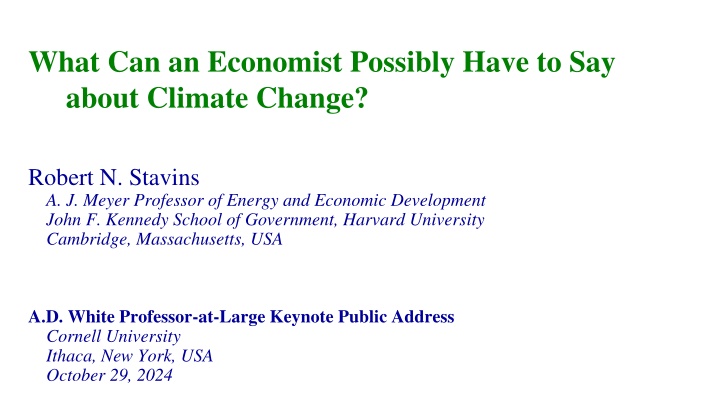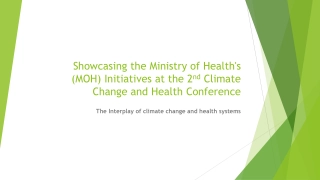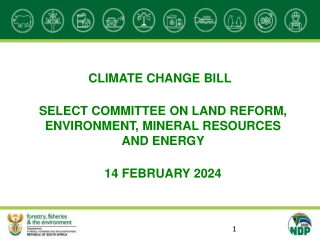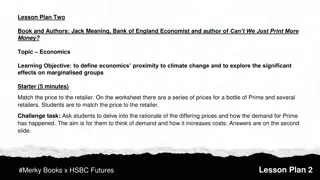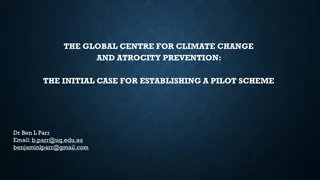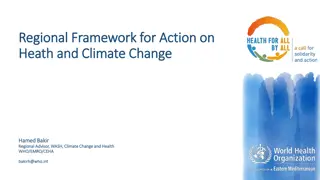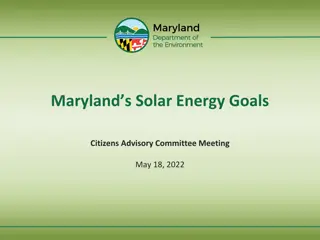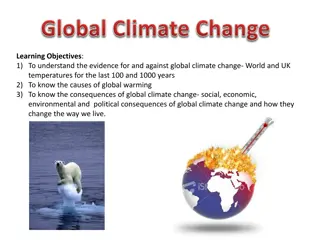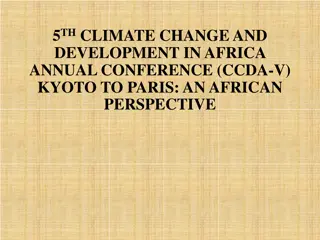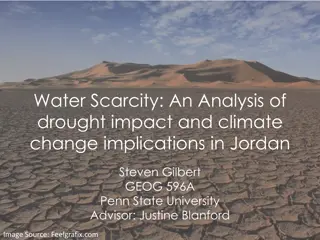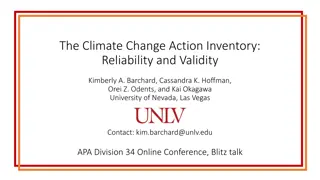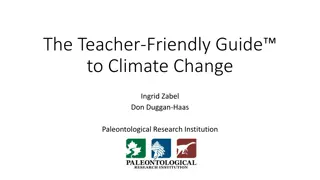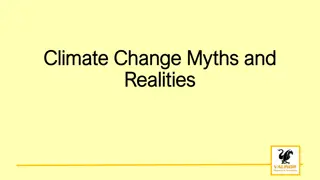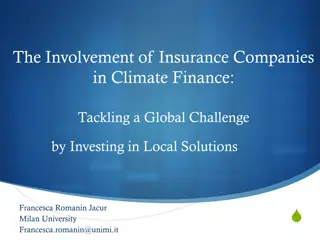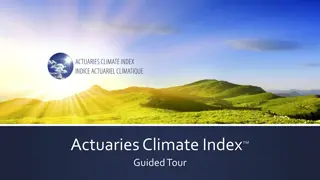The Economics and Politics of Climate Change
Environmental economist Robert N. Stavins discusses the economic dimensions of climate change, emphasizing the global nature of the problem and the challenges of international cooperation, intertemporal asymmetry, and political incentives.
Download Presentation

Please find below an Image/Link to download the presentation.
The content on the website is provided AS IS for your information and personal use only. It may not be sold, licensed, or shared on other websites without obtaining consent from the author.If you encounter any issues during the download, it is possible that the publisher has removed the file from their server.
You are allowed to download the files provided on this website for personal or commercial use, subject to the condition that they are used lawfully. All files are the property of their respective owners.
The content on the website is provided AS IS for your information and personal use only. It may not be sold, licensed, or shared on other websites without obtaining consent from the author.
E N D
Presentation Transcript
What Can an Economist Possibly Have to Say about Climate Change? Robert N. Stavins A. J. Meyer Professor of Energy and Economic Development John F. Kennedy School of Government, Harvard University Cambridge, Massachusetts, USA A.D. White Professor-at-Large Keynote Public Address Cornell University Ithaca, New York, USA October 29, 2024
What business are you in? I m an environmental economist. 1
Environmental economics is not oxymoronic 1. The causes of environmental problems (in a market economy) are economic unintended side-effects of market activity ( externalities ). 2. The consequences of environmental problems have important economic dimensions. Therefore, an economic perspective is helpfulfor A full understanding environmental problems And therefore can be very helpful for the design of solutions that will be effective, economically sensible, and (perhaps) politically feasible. Economic thinking is particularly important for the formulation of effective, sensible, and politically feasible climate policies 2
Science Economics Geopolitics of Climate Change Greenhouse gases mix in the atmosphere, so the location of emissions has no effect on impacts in economic terms, climate change is a global commons problem Any jurisdiction taking action incurs the costs of its actions But climate benefits are distributed globally Therefore, for virtually any jurisdiction, the climate benefits it reaps from its actions will be less than the costs it incurs . despite the fact that the global benefits may be greater possibly much greater than the global costs This presents a classic free-rider problem, . which is why international, if not global, cooperation is essential, and why the highest levels of effective governance (typically countries) are key. There s also a temporal dimension that takes us from science to economics to politics & policy 3
More Science Economics Geopolitics of Climate Change Greenhouse gases accumulate in the atmosphere (100+ years for CO2) Damages are a function of the stock, not the flow If global CO2emissions begin falling tomorrow by 5%/year, the rate of warming won t begin to change in a detectable way until after 20 years (Nature 2020) So, greatest benefits of climate policies will be over the long term, but climate change policies and the attendant costs of mitigation will be up front This combination of up-front costs and delayed benefits presents a great political challenge Political incentive in democracies is to give benefits (to voters) today, and place costs on future generations The climate problem asks politicians to do precisely the opposite! Together, the global commons nature of the problem plus its intertemporal asymmetry make climate change a very tough political challenge. 4
Economists (& Policy Analysts) Tend to Favor Carbon-Pricing Two major forms: Carbon Tax & Emissions Trading Carbon Tax (levy) Tax on carbon content of fossil fuels, not on CO2 emissions per se Revenue can be used for variety of purposes, including reducing distortionary taxes, compensating burdened parties, funding R&D Compliance cost is certain, but quantity of resulting emissions is uncertain Carbon Emissions Trading System (Cap-and-Trade) Allocate allowances for carbon content of fossil fuels, not emissions Allocation can be via free distribution or by auction Auction revenue can be used for same purposes as above Allow trading: supply & demand for allowances generates a price Quantity of resulting emissions is set, but compliance cost is uncertain 5
Why do Policy Analysts Favor Carbon-Pricing? 1. No other feasible approach can provide meaningful emissions reductions 2. Least costly approach in short term (heterogeneous abatement costs) 3. Least costly approach in long term: incentive for carbon-friendly technological change -- innovation (& diffusion) Note: carbon pricing may be necessary, but is not sufficient. Why? Other market failures: principal-agent problem (e.g. energy-efficiency investments in renter-occupied buildings) And public-good nature of information spillovers (e.g., Apple & Blackberry) 6
Worldwide Status of Carbon Pricing Major CO2 emissions trading regimes in place & announced (as of October 1, 2024) European Union Emissions Trading System Washington State Cap-and-Invest New Zealand Emissions Trading Scheme California s AB-32/398 GHG Cap-and-Trade System Regional Greenhouse Gas Initiative South Korea Emissions Trading Scheme China s National Carbon Trading Market $63/ton (2008-) $30/ton (2022-) $39/ton (2008-) $30/ton (2013-) $26/ton (2009-) $10/ton (2015-) $10/ton (2022-) Selected carbon (and related energy) taxes (no prices given, because many not CO2 taxes but energy taxes, and exemptions very common) Finland (1990), Norway (1990), Sweden (1991), Denmark (1992), Costa Rica (1997), British Columbia (2008), Switzerland (2008), Ireland (2010), Iceland (2010), Japan (2012), Mexico (2012), United Kingdom (2013), Chile (2014), France (2014), South Africa (2016) Other jurisdictions will not employ carbon pricing, but will use performance standards and/or technology standards instead Less cost-effective than carbon pricing Muted/distorted price signals Still, will place an implicit shadow-price on carbon 7
Carbon Prices and Emissions Coverage of Implemented Policies Of 70+ carbon-pricing systems in place, about half are carbon taxes and half trading Some carbon taxes at much higher levels that cap-and-trade allowance prices. But combining stringency (price) with scope (coverage), cap-and-trade more important in application. ~25% of Global CO2e Emissions 8
Carbon Pricing Implemented Worldwide, 1990-2021 First phase of China national emissions trading system European Union Emissions Trading System (2005) California Cap-and-Trade System (2012) Source: World Bank, State and Trends in Carbon Pricing content (worldbank.org) 48
Basic Consequences of Carbon Pricing for Fossil Fuels Coal Greatest impacts globally due to high carbon content (electricity generation) Immediate impacts on electricity dispatch Long-term impacts on investment in new capacity Long-term impacts on retirement of existing capacity Natural Gas Smaller impacts, because of lower carbon content And demand increase in short term due to substitution for coal (in USA) But likely effects of anticipated carbon pricing small compared with effects of increased supplies due to horizontal drilling & hydraulic fracturing Oil Potentially significant impacts muted in the very short term Limited substitutes for liquid fuels in transportation sector means relatively high marginal CO2 abatement costs; so a cost-effective portfolio would not target oil But increasing penetration of EVs, growth of biofuels (ag waste, used cooking oil), and greater fuel efficiency petrol demand may decline post-2026 Effect muted by growing demand for aviation fuel and for petrochemicals 10
Economic Impacts will Vary Across & Within Sectors Fuels & Energy Generation Bad news for coal (ceteris paribus), even in short term; mixed for natural gas, possibly muted for oil Good news for renewables, and possibly for nuclear (again, ceteris paribus) In other sectors, climate policies increase energy costs, so simple rule-of-thumb: Bad news for sectors that use energy (i.e., all sectors), but Can be good news for producers of energy-consuming durable goods (Boeing, Airbus) Particularly bad news for consumers of those same energy-consuming durable goods (United Airlines, Lufthansa, etc.) 11
What about Subsidies? Politicians strongly prefer giving out benefits rather than imposing costs So, why not subsidize use of renewable energy rather than taxing fossil fuels? (see the IRA, for example) Aren t these policy instruments symmetric, in which case a subsidy would be potentially cost-effective? When climate externality is taxed, less fossil fuels and less overall electricity, for example, are used, given higher prices Can this outcome be achieved by subsidizing clean energy? No, by subsidizing clean energy, market-clearing price for all electricity is reduced, so overall electricity demand (use) increases Also, can provide other perverse incentives the rebound effect: effect of subsidized (cheaper) insulation (vs effect of energy tax): change thermostat to keep house warmer in winter & cooler in summer And requires large public expenditures per unit of effect, because not only marginal units receive the subsidy, but all of the infra-marginal ones as well (those who would have done it anyway ) Reminder: It s a global commons problem, so international cooperation is necessary 12
The Paris Climate Agreement (COP21, 2015) A Major Step Forward A landmark climate accord, a dramatic departure from previous 20 years (UNFCCC, 1992; Kyoto, 1997) Provided a broad foundation for meaningful future progress So, new approach could be key step toward reducing threat of climate change Fundamental Structure: Hybrid International Policy Architecture Top-down (like Kyoto Protocol, 1997): Centralized oversight, guidance, and coordination Bottom-up: Nationally Determined Contributions (NDCs targets and actions) that arise from or at least are consistent with national policies and politics But whether the Agreement is truly successful may not be known for decades Paris Agreement provides an important opportunity going forward Key necessary condition met: adequate scope of participation (14% KP 97% PA) Other key necessary condition: adequate ambition of NDCs and national policies So, plenty of challenges remained for international negotiations from COP 21 to COP28 13
COP28 in Dubai, United Arab Emirates (December 2023) Press hailed COP28 a great success or a distinct failure, largely based on one sentence in closing statement (officially the Decision of the First Global Stocktake and unofficially the UAEConsensus ) about the future of fossil fuels: Endorsement of transitioning away from fossil fuels in energy systems, in a just, orderly and equitable manner Compromise Above endorsement (instead of phasingdown or phasingout fossil fuels) was combined with endorsement of renewables, nuclear, abatement and removal technologies, plus endorsement of tripling global renewable-energy capacity and doubling annual rate of energy- efficiency improvements Hence, approved by rich oil-producing Middle East countries, industrialized nations, & developing countries Vacuous Statement or a ParadigmShift? (COP 28 President Sultan Al Jaber) Essentially a non-binding resolution about future ambitions, but statement and its press coverage may have symbolic, signaling value 14
So, Was COP28 a Success or a Failure? Most COPs are neither successes nor failures Except when a new agreement is reached (Kyoto Protocol, 1997; Paris Agreement, 2015), the COPs have more in common with annual World Economic Forum (in Davos, Switzerland) than with WTO meetings COPs and Davos are complex get-togethers, based on bottom-up processes. Corporate CEOs in Davos do not agree to take action, then go home to their Boards of Directors to implement their Davos commitments Causality runs in opposite direction So too with COPs, the delegations from the 195 Parties bring to the COPs their domestic priorities. Each COP s outcome is essentially the aggregation of those What really drives action around the world (cuts in GHG emissions) is combination of market realities and public policies. Policies are largely enacted at the national level (and sometimes sub-national level) Those policies are linked with what happens at the annual COPs, but the direction of causation is fundamentally bottom-up, not top-down. 15
So, what was the most important COP28 development? Most important development occurred 8,000 miles away in California two weeks prior U.S. President Joe Biden and China President Xi Jinping met in Sunnylands, California, and signaled in writing renewed cooperation on climate change Statement of cooperation trickled down to leaders of two negotiating teams John Kerry and Xie Zhenhua U.S.-China cooperation is essential for meaningful progress on climate change Without that cooperation (during Obama years), Paris Agreement would not exist! and the Sunnylands Statement jointly signed by the two presidents in November 2023 may ultimately be more important than any individual accomplishment at COP-28 in Dubai. 16
Structure of UNFCCC and Evolution of the Annual COPs UNFCCC specifies any non-governmental entity, which is qualified re topics of Convention can be represented at the Conference of the Parties as an observer(UNFCCC 1992, Article 7, paragraph 6) An explicit role for observer organizations from civil society (NGOs, trade associations, universities, etc.) Evolution over Time Gradual changes in relative importance and prominence of core country delegations of negotiators versus observers from civil society Sixteen years ago (my first COP), 90-95% of meaningful action was in the negotiations, with 5-10% among the participants from civil society By the time of COP28, 10% of meaningful action was within the negotiations, and 90% among the official Side Events, unofficial presentations and sessions, meetings, and interactions among gov ts and civil society. The COP is to a large degree a trade fair with entrepreneurs of all kinds promoting their products The COP is a circus in which the main event is eclipsed with increasing frequency by the side shows Hence, the festivities in Dubai were, in effect, Climate Expo 2023 Not cynicism or even skepticism, because like Davos, the annual Climate Expo plays a role Great examples of this in Dubai were events targeting a specific non-CO2greenhouse gas methane. 17
The Prominence of Methane at COP28 Methane received greatly increased attention from civil society (business associations, NGOs) CH4 has much greater radiative forcing per unit than CO2, but much shorter atmospheric lifetime Over 100 years, radiative forcing per unit of CH4 20 times > CO2; over 20 years, 80 times > CO2 Methane emissions account for 30% of warming since pre-industrial times, and nearly half this decade Can be in financial interests of O&G companies to reduce emissions Included Harvard Initiative to Reduce Global Methane Emissions (4 presentations, 20+ meetings) Oct 31 Multiple Developments New U.S. EPA regulations to cut O&G CH4 emissions by 80%, & $1 billion pledged help for poor countries Global Methane Pledge (to cut global CH4 emissions by 30% by 2030) expanded to 155 countries with Turkmenistan, Kazakhstan, & 3 others joining U.S., China, & UAE held a methane summit World Bank Global Flaring and Methane Reduction Partnership, Global Methane Hub, Oil and Gas Methane Partnership 2.0 (120 companies in 60 countries covering 35% of production), Oil and Gas Climate Initiative s Satellite Monitoring Campaign But will pledges and actions from private industry, NGOs, and governments yield real emissions reductions? 18
Disappointments and Progress at COP28 Two Disappointments Adaptation received great attention in COP28 Decision, but not Funding Perhaps because of diverted attention: Loss and Damage Fund contributions reached $700 million (but less than 1% of likely eventual L&D demand) Major Setbacks for Article 6 Some countries tried to re-open what had been settled issues regarding nature of Article 6.2 mechanism General politicization of Article 6; steps toward implementation blocked Path Ahead COP28 was a coming-out party for private-sector climate action (Nathaniel Keohane, president, C2ES) Hundreds of companies from diverse sectors showcased climate-friendly technologies, management practices, adaptation, and finance A negative or positive development? COP28 completed first 5-year Global Stocktake; countries will submit new NDCs by COP30 The marathon relay (not a sprint) continues to COP29 (Baku, Azerbaijan, 2024) & COP30 (Brazil, 2025) 19
Key Options for the Institutional Path Ahead Copenhagen (COP-15) illustrated problems with process under United Nations 197 countries, but 20 account for 90% of global emissions; and default voting rule was consensus Major Economies Forum accounts for about 90% of global emissions; but initiated and led by USA, and forum for discussion, not negotiation G20 finance ministers; similar to MEF list Climate Club Coalition of the Willing -- Club of National Carbon Taxes or Carbon-Market Coalition Benefits: greater c/e, reduced competitive distortions, free-riding, and leakage, and by providing exclusive membership benefits, club can encourage participation What if the major industrialized countries agree to price carbon domestically, and they agree to enforce border tariffs on non-participating trading partners? (Sounds like the CBAM) Many countries might decide that it makes more sense to join the club, and collect their own carbon taxes (or auctioned allowance revenue), rather than to pay tariffs to the club (This is actually happening!) 20
Beyond Paris We will not know about ultimate success of Paris Agreement for many years International cooperation essential, but key action will be at national levels Paris Agreement provides important opportunity for new path forward One key necessary condition met: adequate scope of participation Other key necessary condition: adequate ambition of policies Paris was only the first step, review NDCs every 5 years But even first NDCs significant: 2100 political target 2o C; BAU was 5-7o C; Paris NDCs can lead to 3.0o C (Kigali Amendment to Montreal Protocol reduces HFCs by 80% over 30 years will shave an additional 0.5oC) if fully implemented in all jurisdictions In years to come, major locus of international cooperation may continue to be UNFCCC, other existing venues, or climate clubs But under any of these venues, the value of an economic perspective remains! 21
Environmental Economics is not an oxymoron. An economic perspective is essential for a full understanding of environmental problems. Economic analysis is key for design of solutions that are: environmentally effective economically sensible politically pragmatic 22
Thank You! 23
For More Information Harvard Project on Climate Agreements www.belfercenter.org/climate Harvard Environmental Economics Program www.hks.harvard.edu/m-rcbg/heep Website www.stavins.com Blog http://www.robertstavinsblog.org/ Twitter @robertstavins Salata Institute Initiative on Reducing Global Methane Emissions https://salatainstitute.harvard.edu/projects/methane/ 24
